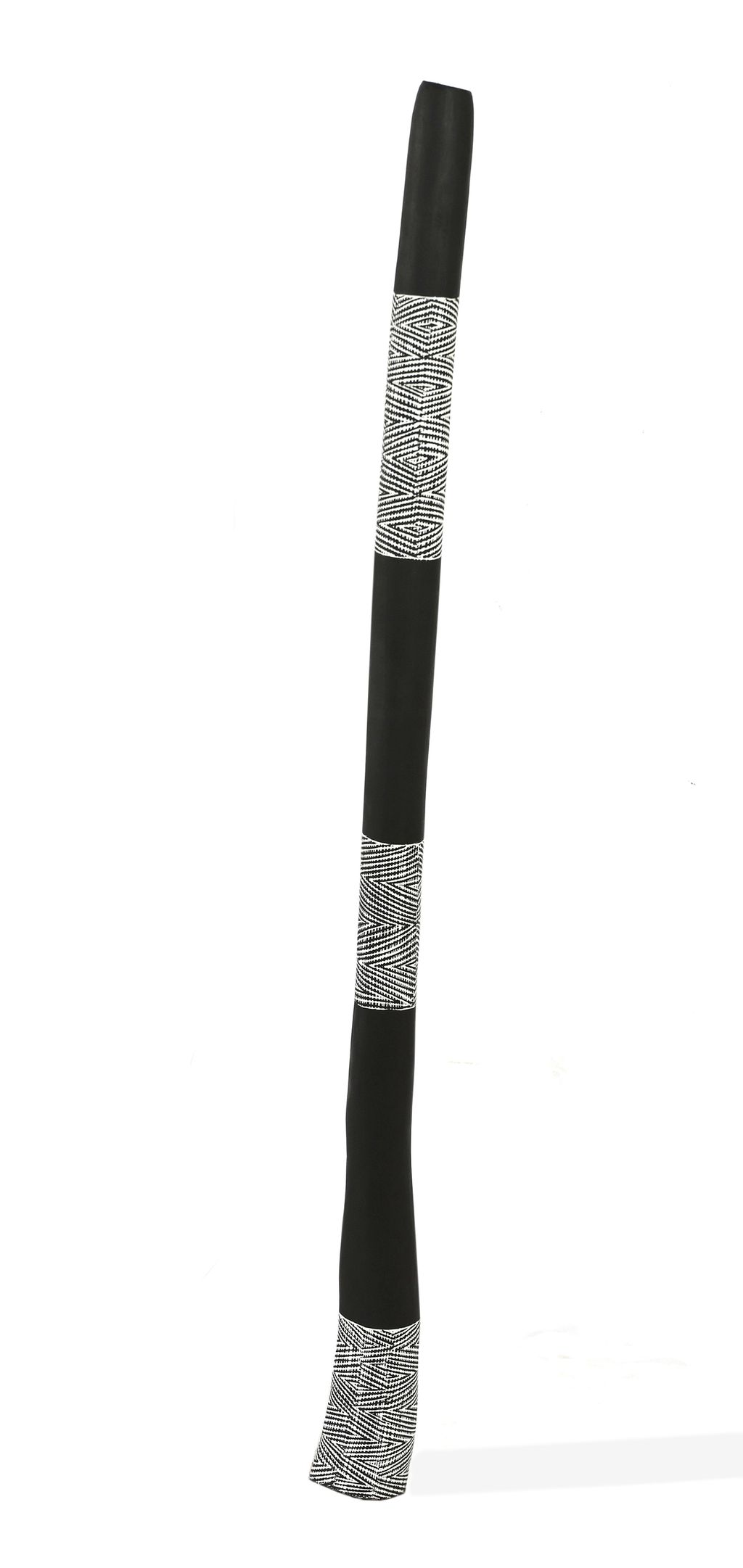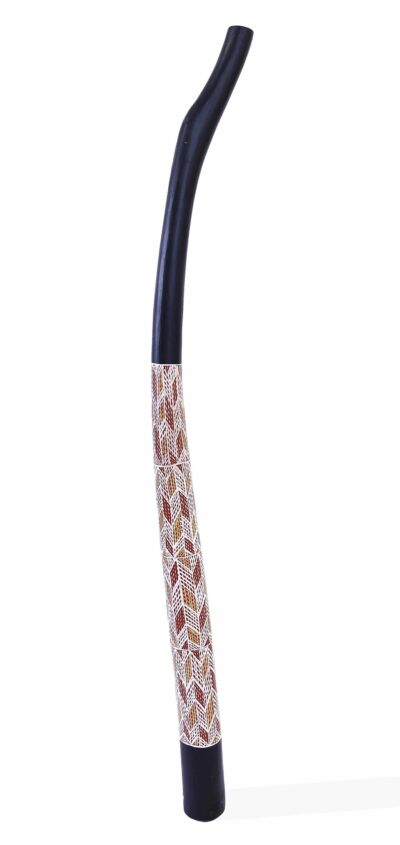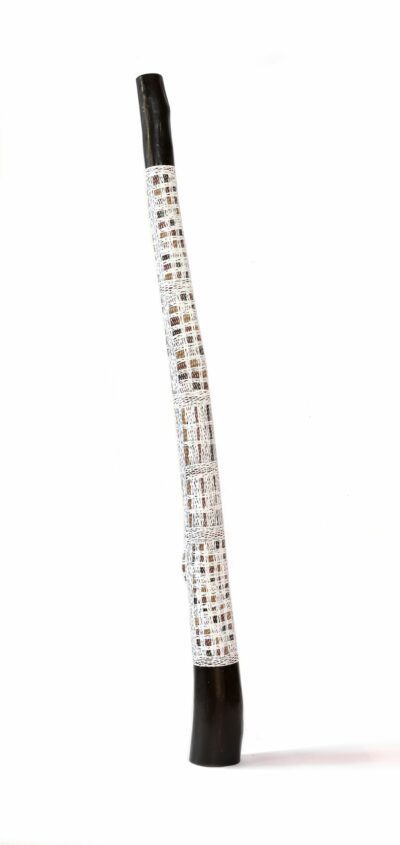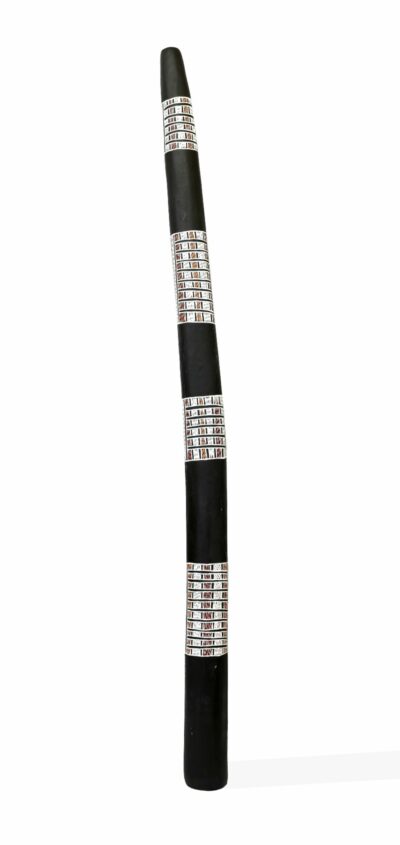Description
milminyina dhamarrandji
Earth pigments on Stringybark hollow pole
120 x 9cm
Year: 2023
ID: 5169-23
Yiḏaki in E (drone) / A (toot)
Yiḏaki are didjeridus that are specific to North East Arnhem land in Australia’s Northern Territory, where the instrument originates. The term yiḏaki is used in Yolŋu (the nation of North East Arnhem land Aboriginal people) languages as the generic name for the didjeridu. The name yiḏaki is most correctly used for instruments from this region that have been solely made and decorated by Yolŋu people.
Yiḏaki were originally limited to the Northern extremes of Australia, in particular Arnhem land. In relatively recent years, yiḏaki spread to other parts of Australia and the rest of the world. Yiḏaki began to be manufactured in different ways and with different types of materials. It became commonly known as the didjeridu, a non-Aboriginal term for the instrument. Through it’s International popularisation as the didjeridu, it has been somewhat displaced from it’s spiritual and cultural roots that are still held by the Yolŋu in Arnhem land today. The Yolŋu are masters of making and playing the yiḏaki and are well known Internationally for their quality instruments and complex yiḏaki playing styles.
Yolŋu artists carefully select naturally occurring termite hollowed tree stems, which are cut and shaped into suitable sounding instruments. They are made with certain desired acoustics that can vary dramatically between different clans, from high pitch to very low. Typical yiḏaki have small natural wooden mouthpieces around 30mm in diameter and taper out to a diameter of around 100mm at the distal end. Having a small mouthpiece means they require less air to play and produce sound easily as a result.
The vast majority of yiḏaki are made from Gadayka (Stringybark – Eucalyptus Tetrodonta). Gadayka is by far the most common tree in the North East Arnhem land region and often grows in a conical shape, which is desired for acoustic reasons. Occasionally, Guŋurru ( Woolybutt – Eucalyptus Miniata) is used.
In appearance yiḏaki seem to be a simple instrument, however the playing styles of the Yolŋu are complex and require many years of practice. Yiḏaki are played by vibrating the lips which produces a basic tone. This tone is maintained continually using cyclic breathing and is varied through use of the playing pressure, the tension in the cheeks, the use of the diaphragm, the tongue position and the use of the voice.
Traditionally, yiḏaki are painted with naturally occurring red, white, black and yellow earth pigments. In recent years acrylic paints began to be used. Both the artwork and the sound and overall style of the yiḏaki denote cultural history and law.
This particular yiḏaki has been painted by Milminyina with a Djambarrpuyŋu clan design that refers to Dhambaliya island, off the coast of Nhulunbuy town. Dhambaliya (Bremmer island) is divided in to two clan areas, Gutjaŋan for the Warramirri clan and Ruwak for the Djambarrpuyŋu and Rirratjiŋu clans.
Within the Ruwak area is the ringitj (sacred ceremonial ground) referred to by the ‘deep’ Djambarrpuyŋu name of Ŋurruyurrdjurr. During ceremony, the men dance in this area with long spears made from mangrove shoots that grow on the island. These spears are named Dhumudal (Djambarrpuyŋu) and Warrarri (Rirratjiŋu). The ceremony refers to Darrpa (the Kingbrown snake), Wuwarku (Taipan) and Dhabaniny (Death Adder).
After the ceremony these bapi (snakes) move towards the coast, to a point called Rirrawutha, where they ‘wash’ their teeth in the water, symbolic of a spiritual cleansing. Rirrawutha can been seen from Wirrwawuy (the birthplace of Milminyina) as upstanding rocks on the Western side of Dhambaliya. These rocks also symbolise the snakes mentioned above.
The riŋitj grounds Ŋurruyurrdjurr are also found on another small island off the coast of Galiwinku. These two places of the same name are sung by the Djambarrpuyŋu and connect through the saltwater Rulyapa (arc shaped miny’tji commonly painted by the Rirratjiŋu) and the spiritual movements of the above mentioned bäpi.






Reviews
There are no reviews yet.